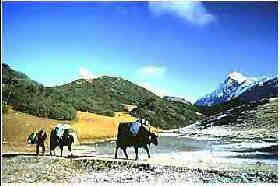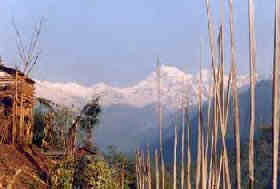SIKKIM & DARJEELING
SIKKIM TOURS  01 Day:
01 Day:
Fly Kathmandu to Bhadrapur. Upon arrival drive to Darjeeling. Overnight at Darjeeling.
Day 02:
Early morning excursion to Tiger Hills (2590m) for Sunrise and Kanchenjunga view. After lunch drive to Pamayantse. Overnight at Pamayentse.
Day 03:
Sightseeing of Pamayentse monastery. Afternoon sightseeing of Tashiding Monastery. Overnight at Pamayentse.
Day 04:
Drive from Pamayentse to Gangtok – capital of Sikkim. Overnight at Gangtok.
Day 05:
Sightseeing of Gangtok. Overnight at Gangtok.
Day 06:
Drive from Gangtok to Kalimpong. Overnight at Kalimpong.
Day 07:
Sightseeing of Kalimpong. Overnight at Kalimpong.
Day 07:
Drive from Kalimpong to Bhadrapur and fly back to Kathmandu.
QUEEN OF HILLS - DARJEELING TOURS
 01 Day:
01 Day:
Early morning transfer to the domestic airport for the flight to Bhadrapur. Upon arrival in Bhadrapur (329 ft) airport meet, assist and transfer to the waiting vehicle for the drive to Indian - Nepal Border i.e. Kakarvita (Nepal side) and Pani-tangki (Indian side). After clearing our papers from both the immigration check post as well as the custom check post we then drive towards Bagdogra to pick up two more guest from Bagdogra. From Siliguri we drive for another 4 hours to reach Darjeeling.
Darjeeling; "the place of the thunderbolt" - The world-renowned hill resort of Darjeeling is a welcome respite for many Indians during the hot summer months. Situated at 2,134 m above sea level, it is stones throw away from Nepal's Eastern border. Darjeeling was acquired by the British from the Raja (King) of Sikkim as a gift around a hundred and fifty years ago; it was developed into a rest and recreational center for British troops. Today the town retains many of the legacies of the British Government.
" The one land that all men desire to see, and having seen once- by even a glimpse- would not give that glimpse for the shows of the rest of the world combined." Mark Twain
Dinner and Overnight at the Hotel.
Day 02
Full day sightseeing in Darjeeling
AM: Late morning after breakfast visit the Padmaja Naidu Himalayan Zoological Park (Zoo) Padmaja Naidu Himalayan Zoological Park is the only Zoo in the world to breed Tibetan Wolf in Captivity and the first South Asian Zoo to breed Snow Leopard and Siberian Tiger and Red Panda. It is situated at an elevation of 2133.5 meters against the glorious background of the mighty Kanchenjunga. It was established on the 14th August 1958 under the Department of Education of the State for study and conservation of the Himalayan Fauna. On 21st November 1975, the zoo was dedicated by Shrimati Indira Gandhi, the then Prime Minister of India, to the memory of Shrimati Padmaja Naidu, former Governor of West Bengal. Since then the zoo is known as "Padmaja Naidu Himalayan Zoological Park".
Later visit the famous Himalayan Mountaineering Institute (HMI) - "The lure of the Himalayas is spreading now all over India among our young people, and that is a sign and symbol of the new life and the new spirit that is coursing through India's veins" - Pandit Jawaharlal Nehru (Founder President HMI) Tenzing Norgay’s ascent of Mt. Everest (8848m /29,028 ft) along with Sir Edmund Hillary, in 1953 provided the impetus to mountaineering as an organised sport in India, and it was to commemorate this singular success that the Himalayan Mountaineering Institute (HMI) was founded in Darjeeling with the personal initiative of Late Pandit Jawahar Lal Nehru, the first Prime Minister of India. The Institute was established on 4th November 1954, which was then the hub centre of all mountaineering activity in India. Late Maj N.D. Jayal was the first Principal of the Institute whereas Late Tenzing Norgay was Director of Field Training. The Institute is located at an altitude of 6800 feet above sea level. The Swiss Foundation for Alpine Research was approached to prepare a scheme for the HMI and Arnold Glatthard, Principal of Swiss Mountaineering School, Rosenlaui, visited Darjeeling for this purpose and made the necessary recommendations. The Institute has 3 mains wings; a) Training Wing B) Museum C) Administrative Wing. One can see the equipments and personal items used by Tenzing Norgay for his ascent to Mt. Everest.
Also visit the Tibet Self Help Center. Darjeeling has some interesting places to watch the local handicrafts being made as well as a various range of choice handicraft souvenirs. The Tibetan Refugee Self Help Centre is a self-supporting Centre for Tibetan refugees, which manufacture some intriguing Tibetan handicrafts. Established for the rehabilitation of Tibetan refugees who had followed the Dalai Lama to India in early 1959. It offers a wide choice of Tibetan handicrafts and Tibetan woollen carpet. Hayden Hall, a Roman Catholic social service centre also has a handicraft section with the purpose of helping the local poor people.
PM: After lunch visits the Happy Valley Tea Estate. Happy Valley Tea Estate is located in East Valley of Darjeeling at an altitude of 2750 mts. It has a planted area of 110.88 Hectars. At present there are 86 running gardens producing 'Darjeeling Tea' on a total area of 19,000 hectares. The total production ranges from 10-11 million kgs annually.The Darjeeling tea industry at present employs over 52 thousand people on a permanent basis,while a further 15,000 persons are engaged during the plucking season which lasts from March to November.A unique feature of this work force is that more than 60 percent are women and the employment is on family basis.The income of garden worker is half in the form of cash and the other half by way of perquisites which have over the years effectively provided with free accommodation, subsidized cereal ration and free medical benefits. Gardens used to run primary schools that have since been taken over by the government but the building continued to be maintained by the garden management.
According to the census carried out in the hills in 1971, the total population of three hill subdivisions of district viz. Darjeeling, Kurseong, Kalimpong was approximately 600,000.From the record maintained by the tea gardens, the resident population is over 300,000.Apart from Tourism, Tea is the biggest industrial activity, offering the largest employment in the hills. The turnover of the Darjeeling tea industry is nearly USD 7.5 million, which is acknowledged to be more than the money generated by tourism in the Darjeeling hills.
Rest of the evening is free to relax.
Dinner and Overnight at hotel.
Day 03:
Drive Darjeeling / Gangtok
Full Day Sightseeing in Gangtok
AM: Visit Enchey Monastery - It is situated adjoining the Siniolchu Tourist Lodge, 3 kms from Gangtok town. This monastery is an important seat of the Nyingrna order, the Enchey Monastery is built on the site blessed by Lama Druptob Karpo, a tantric master known for his power of flying. This 200 years old monastery has in its premises images of Gods, Goddesses and other religious objects. Every year, around January, 'Chaam' or religious masked dance is performed with great fanfare for two days.
Later visit the Government Institute of Cottage Industry. This institute is located at zero point, few km uphill from the main Gangtok town. It was established, in 1957 with the purpose of promoting the manufacture and sale of local handicrafts, carpets and furniture. An emporium at the institute sells handicrafts; thangkas (scrolls with paintings) hand carved foldable wooden tables known as ‘Choktsees’ and exquisitely woven woollen carpets, mask and dolls. Hand made paper is another unique novelty of the Institute and is made from the bark of a tree Algeri. The paper is used extensively for invitation cards and letter-pads.
Continue the tour towards Dodrul Chorten. The Dodrul Chorten is one of the largest stupas in Sikkim and a very sacred icon to the Buddhists. The Venerable Trulsi Rimpoche built it in 1945 to ward off foreign invasion.
Later visit the Sikkim Research Institute of Tibetology (SRIT) - Situated at Deorali, the SRIT is within walk-able distance from the main town of Gangtok. It was formerly known as the Namgyal institute of Tibetology, after the late Chogyal of Sikkim, Palden Thondup Namgyal whose brainchild it was, the Sikkim Institute of Technology(SRIT), has since become one of the most prestigious depository of Tibetan literature, rare manuscripts, paintings, thangkas, statues and religious objects and other works of art and history.
This institute was established to promote research on the language and traditions of Tibet as well as the Mahayana sect of Buddhism. There are about 30 thousand volumes, mostly xylographs, (xylographs are documents that are printed using wooden slabs that have the matter embossed on them in the reverse) translations of the original teachings of the Lord Buddha, and treatises by distinguished Buddhist scholars from
The museum at the Institute consists of rare collection of antiques like statues, coins and thangkas. This institute is a premier institute in the world that conducts research in the language and culture of Tibet. It has on its faculty eminent scholars. The foundation stone of the Institute was laid in February 1957 by the Dalai Lama and if was inaugurated by Pandit Jawaharlal Nehru in October 1958.
Noon: break for Lunch
PM: After lunch visit the famous Rumtek Monastery also known as Dharma Chakra Centre. This monastery is one of the most important seats of the Kagyu lineage outside Tibet. In the early 1960's, His Holiness the Sixteenth Gyalwang Karmapa founded this seat near the 300 year old Kagyu monastery built in the sixteenth century by the Fourth King of Sikkim under the guidance of the ninth Karmapa. The new Rumtek monastery was built about two kilometers away from this old monastery.
Rumtek became the International Kagyu Headquarters during the life of His Holiness, from where lineage activities manifested throughout the world. It also became the residence of a new generation of Kagyu masters, who are being trained in a tradition of study and meditation practice which began 800 years ago.
Overnight at Netuk House.
Day 04:
Drive Gangtok / Kalimpong (1588 meters)
The drive from Gangtok to Kalimpong covers a distance of 85 kilometers and takes approximately about 2 1/2 - 3 hours. The drive is along the winding road with some beautiful sceneraries of the Kanchenjunga ranges from along the way.
Nestled in the foothills of the Himalayas, the town of Kalimpong is situated at an altitude of 1,250 m. The name, Kalimpong, has three different origins. One, it means the place where the local tribesmen gathered to organize field sports, second, it takes its name from the Bhutanese Kings Ministers stronghold and thirdly, it is named after "Kaulim", a fibrous plant found in abundance in this region
The town offers a breathtaking view of the snowy peaks of the Himalayan range that lies not far beyond it. The lush green valleys are a soothing sight.
Upon arrival check into the hotel. Later visit the famous flower nurseries. Kalimpong is famous for its flowers and nurseries. The region produces 80% of Indias gladioli and is a significant orchid-growing area. Entire hillsides are blaze with colour during the season. Continue and visit the Dr Grahams Homes. Dr Grahams Homes is a complex for orphans and other deprived children which was founded in 1900 on the lower slopes of Deolo Hill. The chapel above the school dates from 1925 and features beautiful stained-glass windows. Tourists can also visit the fine turn-of-the-century school building.
PM: free to visit the bustling bazaar of Kalimpong.
Dinner and Overnight at the hotel.
Day 05:
Drive Kalimpong / Bhadrapur
The drive is along the narrow hilly road covering a distance of ….. kilometres to Kakadivitta Border. After immigration formalities, continue drive to Bhadrapur airport. Upon arrival check into the airport to catch the onward flight.
|
